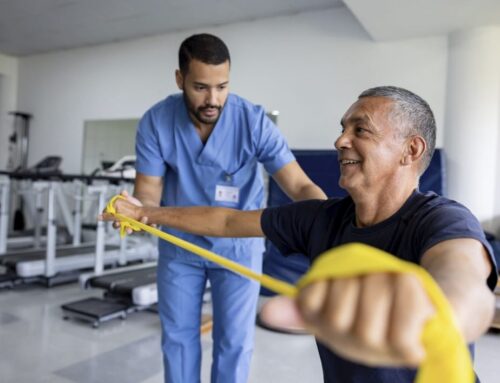As we age, our bodies tend to slow down, injuries set in and the strength we once enjoyed gives way to joint pain and general weakness. There emerges an unsettling realization that affects nearly everyone at some point — developing stability issues profoundly affecting your independence, routines and lifestyle. Surgery can seem to be inevitable for many who suffer from hip, shoulder, back and leg pain as they explore viable treatments. It is normal to feel anxious when faced with the prospect of surgery, and seeking treatment can be stressful if you feel the pain may warrant an invasive treatment. However, many may not consider that pain and stability issues do not always have to lead to surgery. Physical therapy is a conservative, non-invasive treatment option that can be extremely effective in directing you toward a pain-free life.
When to start physical therapy
Patients at the early stages of joint pain benefit the most from physical therapy. If pursued while symptoms are growing noticeable, physical therapy offers pain relief to get back to your regular routine and slows the progression of deteriorating diseases.
Osteoarthritis sufferers can experience pain, stiffness, tenderness, swelling and reduced movement anywhere throughout their bodies, as the cartilage wears down between bones and stops providing protective cushioning. It commonly affects joints in the hands, knees, hips and back. With old age and repetitive joint activation being two primary risk factors, it is easy to see why over 32 million adults in the US are afflicted with this degenerative disease. Physical therapy helps to exercise and strengthen the muscles around joints to make them more flexible and stable.
Hip surgeries are among the most common joint operations because of the pressure they endure during everyday activities. Although physical conditions such as tumors or inflammation can cause the issue, it is most commonly caused by hindered joint motion or weak muscles and ligaments. Physical therapy effectively regains strength and flexibility in the area, providing increased stability and reduced pain.
While these are two groups that can see great value in PT, anyone suffering from mild to severe joint or musculoskeletal pain should consider physical therapy as a course of action. If you have lower back, shoulder, hip or knee pain from a fall, sports injury or prolonged wear and tear, surgery will often be a recommended option but not necessarily the path you have to take. Talking with a physical therapist to identify issues, get educated and understand your functional goals can reveal practical alternatives and provide peace of mind.
What can you expect at your first PT appointment?
Physical therapy can look different for each patient depending on lifestyle and the evaluation made by the therapist. The therapist performs a thorough assessment of symptoms and researches medical history. The therapist will strive for an intimate understanding of daily activities, identifying painful activities and situations. This consultation is usually followed by a physical examination to create a unique, guided program for rehabilitation.
A primary role of a physical therapist is as an educator. During the evaluation process, a physical therapist may look at your usual manner of walking, sitting, lifting or even getting in and out of bed. Much of the wear that contributes to joint pain and poor stability is caused by problems with posture, walking gait or simple body movements that normally go unnoticed. Therapists provide valuable insight and teach corrective positioning to fix movements that contribute to pain.
When the impairment’s specifics are pinpointed, a detailed course of action centered on exercise and mindfulness is formulated. Physical therapy’s key goals are reducing pain, restoring mobility, building targeted muscle strength, and increasing physical fitness and flexibility. Plans include everything from strengthening exercises to special stretches and modalities for pain management. These can consist of heat/ice, electrical stimulation, bracing, IASMT, Kinesio taping, dry needling, laser, blood flow restriction and soft tissue mobilization/manual therapy.
Is physical therapy effective?
Physical therapists go through years of training in areas such as biology, anatomy, physiology and behavioral sciences. They build a comprehensive background to tailor unique treatment programs and make recommendations based on the patient’s goals. Patients can find specialized therapists for various medical conditions, including pulmonary disorders, neurological conditions and sports-related injuries.
Physical therapy is an exceptionally proactive approach to rehabilitation for joint pain sufferers and those with stability issues. With the level of specialization physical therapy requires, the largest benefit comes in the treatment’s customization.
Physical therapists create holistic approaches to treatment that can be easily integrated into your life without altering it. Unlike surgery, there is no recovery time from physical therapy because the treatment is the recovery. They interact with you to use your own body as the primary tool in the rehabilitation process, organically building strength and dexterity. For much of the process, you control the intensity and the progression of the treatment, with many of the exercises being done at your pace within your home. Therapists plan and react to expected changes in your lifestyle based on their communication with you and understanding your needs and treatment goals.
Physical therapists in Raleigh
The concept of losing your independence and no longer being able to live your active lifestyle is a troublesome one and often it seems that surgery may be the only path to treatment. Many avoid the doctor specifically because they are worried about the unknown, not wanting to hear bad news and face the potential for invasive treatment measures. However, mobility issues can be life-threatening. If you are experiencing extreme pain or a lack of stability is causing serious safety issues, you should speak with an orthopedic specialist. With simple lifestyle adjustments, physical therapy can help you continue doing the activities you love and retain your independence for years to come.
The skilled physical therapists at Cary Orthopaedics work closely with our physicians to make your full recovery their number one goal. Learn more about conservative treatments by making an appointment today.






